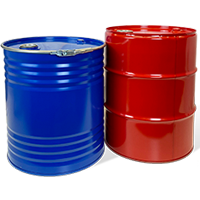GENERAL FEATURES
- MASTIC P-2049 is a two-component, UV resistant, rapid curing, polyurea for filling control and construction joints in industrial floors.
- can be also used to repair damages or cracks
- very high elongation at break(>450%)
- high resistant to heavy loads
- it absorbs hard wheeled traffic
- do not use as an expansion joint filler
- 100 % solid content
- the application must be done using equipment, to mix both components
- free from harmful VOC compounds, therefore, does not hurt the ozone layer (VOC's zero).
- it doesn´t emit substance to the environment once installed.
PACKAGING
Metal drums of 55 kg each component (B side: amines and A side: isocyanates). Agitate B side (AMINES) before inserting the transfer pump and use.
SHELF LIFE
12 months at temperatures between 5°C to 35°C, provided it is stored in a dry place, keep away from direct sunlight, extreme heat, cold or moisture.
APPLICATION METHOD
In general, you should take the following factors:
- clean up the surface of the joint or crack, removing any dust, dirt, grease or efflorescence.
- remove any silicone-based products
- adhesion tests may be required for certain substrates
- in general, all surface preparation requires the removal of all grease, dirt loose and flaking materials prior to the application of MASTIC P-2049
- in case of doubt of all above, apply before in a restricted area and to check
HEALTH AND SAFETY
These safety recommendations for handling, are necessary for the implementation process as well as in the pre and post, on exposure to the loading machinery. Always read the MSDS before use and handling the product.
- Respiratory Protection: When handling or spraying use an air-purifying respirator.
- Skin protection: Use rubber gloves, remove immediately after contamination. Wear clean body-covering. Wash thoroughly with soap and water after work and before eating, drinking or smoking.
- Eye / Face: Wear safety goggles to prevent splashing and exposure to particles in the air.
- Waste: Waste generation should be avoided or minimized. Incinerate under controlled conditions in accordance with local laws and national regulations.
- Vapor and atomized liquids are harmful
- Use only in ventilated areas, wear approved respirators when necessary
- Keep out of reach of children
- Do not use near high heat or open flame
Anyway, consult the material and safety data sheet (MSDS) of the product. To obtain an MSDS, please call +34935682111 or send an email to dpont@tecnopol.es
TECHNICAL DATA OF THE COMPONENTS
|
PROPERTIES
|
COMPONENT A
|
COMPONENT B
|
|
Specific gravity at 23ºC ISO 1675
|
1,11±5%g/cm³
|
1,09-1,12 ±5%g/cm³ *
|
|
Viscosity (S63, 30 rpm at 23 ºC) ISO 2555
|
900±50 cps
|
650±50 cps *
|
|
Mix ratio – in weight
|
100
|
102
|
|
Mix ratio – in volume
|
100
|
100
|
*: these data only in a neutral color; for other colors, this data may vary, please check COA
TECHNICAL AND CHEMICAL PROPERTIES
|
PROPERTIES
|
RESULTS
|
|
Density ISO 1675
|
1,1 g/cm³
|
|
Elongation at break ISO 527-3
|
>450%
|
|
Tensile Strength ISO 527-3
|
>10 MPa
|
|
Hardness Shore A/D DIN 53.505
|
>90 / >40
|
|
Fire reaction
|
NPA
|
|
Tack free time / total dry time
|
±15 minutes / ±2 hours
|
| Application range temperature |
25-35 ºC |
|
VOC content
|
0 (solids content 100%)
|
Results performed in the laboratory at 23ºC (73ºF) and 50% RH, under controllable conditions. These values may vary depending on the application, climatology, or substrate conditions.








